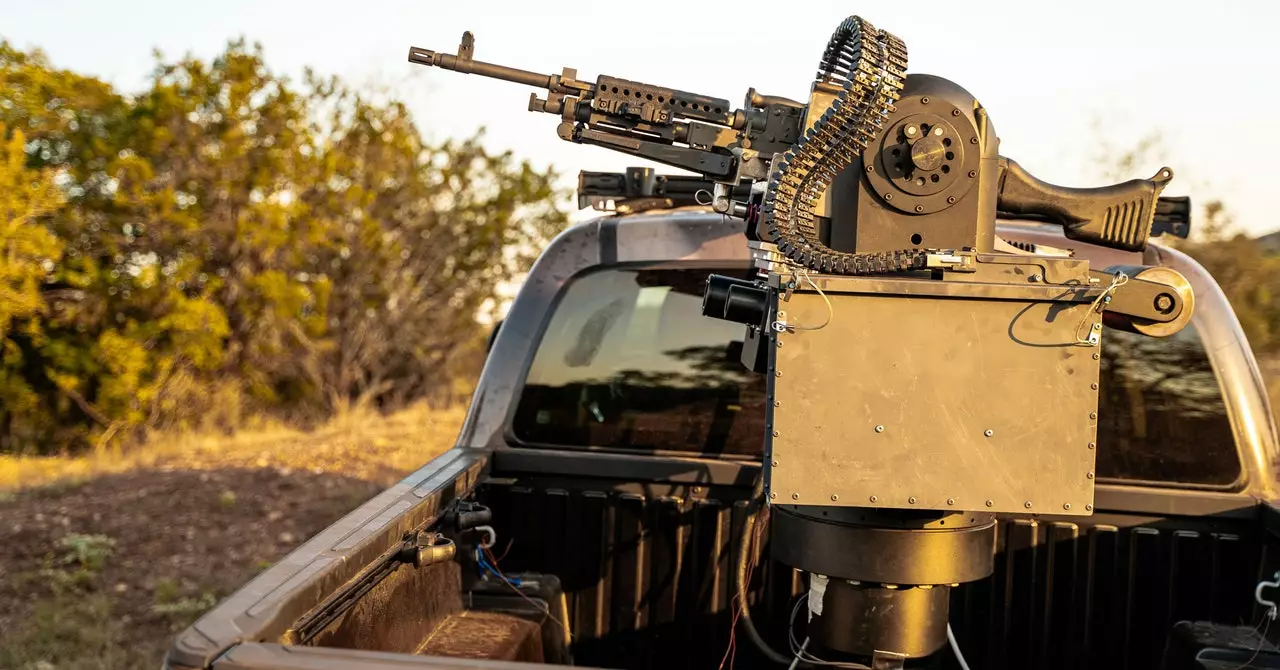As modern warfare continues to evolve, the threats faced by military personnel become increasingly complex. Among these threats is the rampant proliferation of low-cost, weaponized drones that pose a serious challenge to American troops stationed around the globe. In response, the United States military is intensifying its efforts to safeguard soldiers from aerial attacks. While traditional defenses have included costly munitions and cutting-edge directed energy weapons, the Pentagon appears to be turning its attention toward a surprisingly conventional solution: reimagining the gun itself.
At the forefront of this innovative approach is the Bullfrog, an artificial intelligence-enhanced autonomous weapon system developed by Allen Control Systems, a burgeoning defense contractor. Tested during the Technology Readiness Experimentation (T-REX) event in August, the Bullfrog integrates a 7.62-mm M240 machine gun with an advanced rotating turret equipped with electro-optical sensors and proprietary AI algorithms. This design aims to outperform standard-issue firearms like the M4 carbine and the forthcoming XM7 rifle in drone engagements.
What sets the Bullfrog apart is its precision capabilities; recent footage indicates that the system effectively identifies and neutralizes drone threats with remarkable accuracy. According to Defense Daily, Pentagon officials were encouraged by the capabilities displayed during the demonstrations. Alex Lovett, deputy assistant secretary of defense for prototyping and experimentation, highlighted the “low-cost” effectiveness of the Bullfrog, stating that the initial tests had exceeded expectations. If officially incorporated into the military framework, the Bullfrog could mark a pivotal moment, becoming the first known lethal autonomous weapon in the U.S. military’s inventory.
Adapting to Counter Drone Challenges
Conventional firearms struggle to hit small and agile drones, even in the hands of well-trained marksmen. Consequently, the military has explored a variety of solutions to enhance small arms efficacy against these unmanned threats. This has included acquiring small-caliber and “buckshot-like” ammunition—approaches gleaned from the battlefield as evidenced during Russia’s invasion of Ukraine—where shotguns have been effective against aerial targets.
Furthermore, the integration of rifle-mounted jamming technologies offers a complementary strategy by disrupting the drone’s GPS signals or radio frequencies, effectively neutralizing the threat without the need for cumbersome counter-drone weapons. Technologies such as smart optics—developed by companies like SmartShooter and ZeroMark—are also emerging as crucial innovations. These optics promise to maximize hit probability by allowing weapons to fire only once a target is locked. The U.S. Army is even embedding counter-drone training into its foundational curriculum, viewing the threat from drones as critical as traditional marksmanship training.
The approach adopted by Allen Control Systems and other defense innovators signals a paradigm shift in how military technology interacts with the evolving landscape of contemporary threats. As Steve Simoni, co-founder and CEO of ACS, asserts, the key to effectively countering drone threats lies not just in hardware enhancements or fortified training programs, but through the synergistic integration of robotics and sophisticated AI technologies. By significantly minimizing human error in target acquisition and tracking, systems like the Bullfrog promise to transform how aerial threats are engaged.
Simulation and experimentation are expected to become routine in military operations, reflecting the necessity of evolving tactics and tools to meet new challenges head-on. In an era defined by rapid technological advancement, the military must remain agile and responsive. As the Bullfrog demonstrates, innovations in weaponry could not only level the playing field against drone threats but may also indicate a broader trend toward the automation of combat operations.
Ultimately, the US military’s exploration of drones and advanced weaponry reveals deeper implications for the future of warfare. The landscape of combat is being reshaped by technology, emphasizing the importance of adaptability and foresight. As threats become more sophisticated, the military’s responses will likewise need to evolve, balancing the traditional elements of engagement with the transformative opportunities presented by next-generation weapon systems like the Bullfrog. Thus, the dialogue around the future of warfare is more relevant than ever as we enter an era dominated by intelligent systems, requiring a reconsideration of methods and tactics previously thought immutable.


Leave a Reply